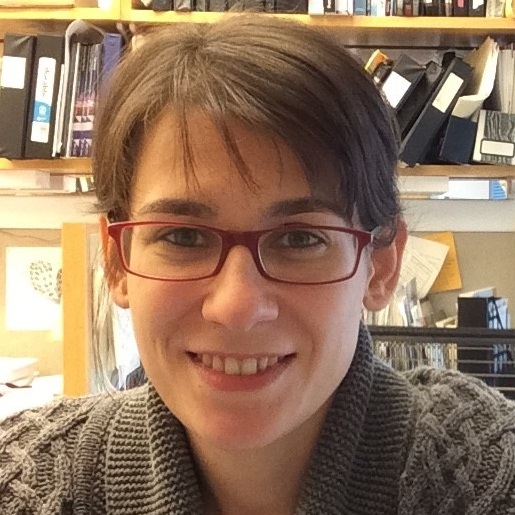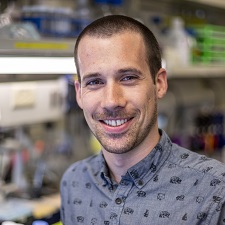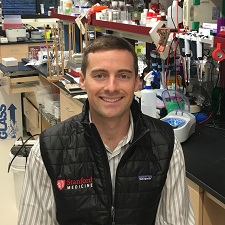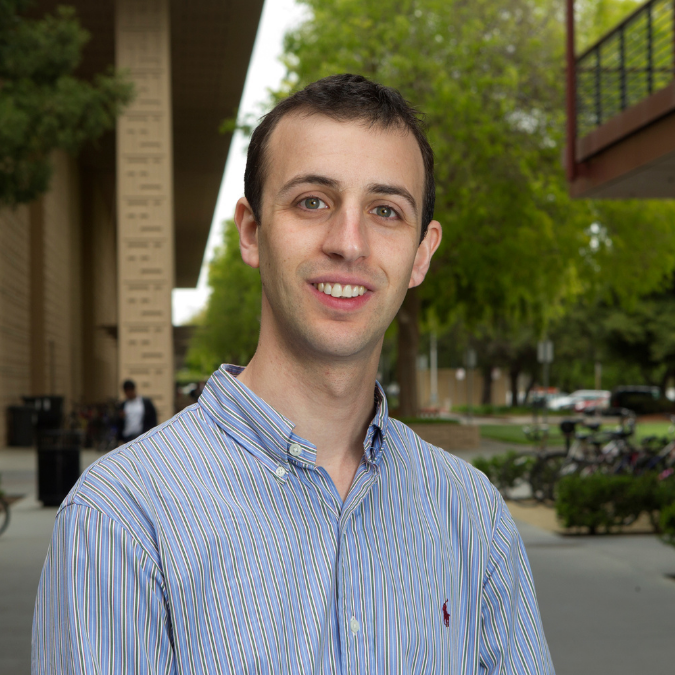Since COVID-19 cases escalated to pandemic levels worldwide, Damon Runyon scientists are contributing to the unprecedented global effort to stop the disease by investigating how this specific coronavirus enters human cells, developing more efficient testing and searching for a treatment. While Damon Runyon’s focus is on cancer, these projects demonstrate how our approach of funding brilliant scientists doing cutting-edge basic, laboratory research can result in benefits for patients in all areas of health.
UPDATE March 3, 2022
A CRISPR-based tool for rapid detection of COVID-19 variants

Researchers in the lab of former Damon Runyon Fellow Pardis C. Sabeti, MD, DPhil, at the Broad Institute of MIT and Harvard have developed a CRISPR-based diagnostic tool that can rapidly identify which SARS-CoV-2 variant (or other respiratory virus) is present in a patient sample. Slightly larger than a smartphone, the tool is dotted with thousands of tiny wells, each designed to hold two nanoliter-sized droplets. One droplet contains genetic material from the sample, and the other contains the CRISPR enzyme Cas13, programmed to detect a specific RNA sequence.
Originally developed in April 2020, the tool (known as mCARMEN) has undergone a number of updates to keep pace with the evolving SARS-CoV-2 virus. It can now distinguish between six different SARS-CoV-2 variants, including Delta and Omicron—as well as flag new variants, should they appear. mCARMEN can also measure the amount of virus in a sample, which helps determine if the patient is contagious or whether a treatment is working.
While not yet approved for clinical use, mCARMEN is currently being used in public health departments nationwide to assist with virus surveillance efforts. “Our hope is to disseminate this technology much more broadly,” says Dr. Sabeti.
Read more: Nature Medicine
UPDATE February 1, 2022
Researchers develop first humanized mouse model of chronic COVID-19

Severe cases of COVID-19 trigger an uncontrolled, hyperactive immune response in humans, resulting in inflammation, tissue damage, and other markers of disease. Mouse models, while critical for the study of virus transmission and vaccine efficacy, do not exhibit the same immune response as humans, and thus are less helpful for investigating chronic, severe disease.
Fortunately, HHMI-Damon Runyon Fellow Esen Sefik, PhD, and her colleagues at Yale University have just unveiled a humanized mouse model—that is, a mouse with a functional human immune system—for the study of COVID-19 and its many complications. By infusing genetically engineered mice with human blood stem cells, delivering the human SARS-CoV-2 receptor to their lungs, and infecting them with SARS-CoV-2, the team was able to recreate in mice the sustained immune response associated with chronic, severe COVID-19 in humans. As this virus and its treatment options continue to evolve, Dr. Sefik’s model will serve as an invaluable tool in the ongoing study of COVID-19 disease mechanisms and therapeutics.
Read more: Nature Biotechnology
UPDATE August 4, 2021
Study of mutations in virus’s receptor binding domain enhances understanding of COVID-19 variants

When Damon Runyon Fellow Tyler Starr, PhD, started his postdoc at Fred Hutchinson Cancer Research Center in 2018, he planned to focus on how mutations in HIV antibodies affect their ability to bind to antigens. But when reports of a new coronavirus began to appear in the news in late 2019, he realized he could adapt his methods to investigate other, newly urgent questions. Dr. Starr set out to characterize how mutations in the SARS-CoV-2 receptor binding domain affect its affinity for the ACE2 receptor on the surface of human cells. His research relies on a technique called yeast surface display, in which proteins of interest are pinned to yeast cell walls like clues on a detective’s cork board. His findings have proven critical to viral surveillance efforts—leading, for example, to the identification of the alpha (UK) and beta (South African) variants of SARS-CoV-2, which have increased affinity for ACE2.
Dr. Starr is also using his yeast display system to identify and optimize antibodies that can be used against SARS-CoV-2 and future epidemic-causing viruses. One such antibody, described earlier this month by Dr. Starr and his colleagues, is being lauded as a “super antibody” due to its ability to prevent a wide range of SARS-CoV-2 variants.
UPDATE June 17, 2021
Former Damon Runyon Fellow helps develop nation’s “most sophisticated” test-and-trace system on Colorado college campus

MD, DPhil
For many colleges across the U.S., the decision to welcome students back to campus last fall was soon followed by an uptick, if not a raging outbreak, of COVID-19 cases in the student body. Among varied attempts to combat spread with regular testing and contact-tracing programs, Colorado Mesa University has emerged as an exemplar, thanks to its partnership with former Damon Runyon Fellow Pardis C. Sabeti, MD, DPhil, and her colleagues at the Broad Institute. Together, the researchers and university administration have developed what Dr. Sabeti calls “the most sophisticated system in the country to track outbreaks.”
The system, known as Lookout, relies on a combination of data input from students about their symptoms and close contacts, hourly results from the campus testing site, and measurements from a wastewater surveillance system that tests dorm sewage for evidence of the virus. By identifying and testing high-risk individuals, alerting students when they may have been exposed, and tracking outbreaks when they do occur, the school has been able to mitigate disease spread and remain open through the year. Now, Dr. Sabeti hopes to apply the lessons learned (such as the importance of involving the wider community in test-and-trace efforts) beyond the university setting, stating: “We’re trying to build technologies that can be used globally. But a school is a great place to start.”
Read more: New York Times
UPDATE March 31, 2021
Host Proteins Protect Against Viral RNA

We know that SARS-CoV-2, like other RNA viruses, injects its own RNA into host cells, providing instructions for the creation of viral protein products that eventually hijack the cell. While a few studies have examined how these virally encoded proteins interact with host proteins, the nature of the interaction between viral RNA and host proteins is less clear—and potentially key to understanding and interrupting infection pathways.
At Stanford University, former Damon Runyon Fellow Ryan Flynn, MD, PhD, and colleagues identified 309 host proteins that bind SARS-CoV-2 RNA during infection and comprehensively cataloged these RNA-host protein interactions. Among their chief discoveries is that the majority of RNA-binding host proteins actually protect the host from virus-induced cell death, and that the mitochondria serve as a platform for antiviral activity. As our understanding of the subcellular mechanisms of SARS-CoV-2 races against the emergence of novel strains, this data helps fill an important gap and highlights previously unappreciated host-protective factors.
Read more: Cell
UPDATE March 4, 2021
FDA Grants Emergency Authorization to Portable PCR Test for COVID-19

Visby Medical, the startup founded by former Damon Runyon-Dale F. Frey Scientist Adam de la Zerda, PhD, at Stanford University School of Medicine, has developed a rapid, portable PCR test designed to identify SARS-CoV-2 (the virus that causes COVID-19) infections in the clinic or doctor’s office within 30 minutes. PCR tests are the gold standard diagnostic tool for confirming a case of COVID-19, but samples need to be sent away for laboratory processing. Visby’s handheld device, granted emergency use authorization by the FDA in February, combines the high sensitivity of laboratory PCR testing with the convenience and speed of traditional rapid antigen tests.
Read More: Fierce Biotech
First CRISPR Test for the Novel Coronavirus Approved in the United States

The US Food and Drug Administration (FDA) has granted its first emergency-use approval for a new SARS-CoV-2 test that harnesses the gene-editing technology CRISPR. The new diagnostic kit is based on the approach co-developed by Former Damon Runyon Innovator Feng Zhang, PhD, at the Broad Institute of MIT and Harvard.
The CRISPR-based diagnostic kit, developed by Sherlock Biosciences, works by programming the CRISPR machinery, which has the ability to home in on certain genetic sequences, to detect a snippet of SARS-CoV-2 genetic material in a nose, mouth or throat swab, or in fluid from the lungs. If the virus’s genetic material is found, a CRISPR enzyme generates a fluorescent glow.
The test can return results in about an hour. Widespread use of the new FDA-approved kit could help to alleviate backlogs in testing patients and provide large scale testing that may be necessary to guidelines for reopening schools and businesses.
Previously, Dr. Zhang and colleagues showed that a CRISPR-based diagnostic could detect low levels of Zika and Dengue virus in 2018. Sherlock Biosciences is working to manufacture and distribute the kits, which could help close the testing gap.
Read More: Scientific American
Researchers Identify Cells Targeted by Novel Coronavirus

The novel coronavirus must enter a person’s cells to cause infection, but not all cells are vulnerable. Researchers have identified specific cells in the lungs, nasal passages, and intestines that are susceptible to the coronavirus (SARS-CoV-2) that is causing the COVID-19 pandemic.
Former Damon Runyon Fellow Jose M. Ordovas-Montanes, PhD, at Boston Children’s Hospital and colleagues at the Broad Institute, Massachusetts Institute of Technology and Harvard, searched for cells that have certain molecules on their surface that provide a “door” for the virus to enter.
The characteristic “spike” protein on SARS-CoV-2 binds to a receptor on human cells known as angiotensin-converting enzyme 2 (ACE2). Another human protein, an enzyme called TMPRSS2, helps to activate the coronavirus spike protein. The combined binding and activation allow the virus to enter host cells. Once inside, the virus hijacks the cell’s genetic machinery to produce viral proteins that come together to form millions of new virus particles.
“We started looking to see where the genes for those two proteins were in our existing datasets,” Ordovas-Montanes says. “We were really in a good position to investigate which are the cells that this virus might actually target.” Much of the data came from labs that belong to the Human Cell Atlas project, which is cataloging the distinctive patterns of gene activity for every cell type in the human body. The researchers focused on hundreds of cell types from the lungs, nasal passages, and intestine based on previous evidence that these cells provided an entryway for the corona. They then compared their results to cell types from unaffected organs.
The researchers found that goblet secretory cells in the nasal passages, which produce mucus, express RNAs for both of the proteins that SARS-CoV-2 uses to infect cells. In the lungs, they found the RNAs for these proteins mainly in cells called type II pneumocytes. These cells line the alveoli (air sacs) of the lungs and are responsible for keeping them open.
In the intestine, they found that cells called absorptive enterocytes, which are responsible for the absorption of some nutrients, express the RNAs for these two proteins more than any other intestinal cell type.
The researchers also found a surprising phenomenon, in which signaling molecules called interferons — which normally help to fend off viruses — switch on the host genes encoding the ACE2 protein. The result suggests that the body’s defenses against viral attack drive the activation of the gene for ACE2, allowing more entry points into cells. Interferon’s potential role in fighting COVID-19 seems to be complex. On one hand, it can stimulate genes that fight off infection or help cells survive damage, but on the other hand, it may provide extra targets that help the virus infect more cells.
The researchers will collaborate to profile tissue models that incorporate the cells identified in this study. Such models could be used to test existing antiviral drugs and predict how they might affect SARS-CoV-2 infection.
Much of the data used in this study was generated in collaboration with researchers around the world and has been made available to other labs who want to use it. This work was published in Cell.
Read More: SciTechDaily
Pharmaceutical Alliance Formed to Develop Drugs for COVID-19

To speed the development of a tailor-made treatment for the novel coronavirus (SARS-CoV-2) causing COVID-19, a pharmaceutical alliance is defying the industry norms for transparency. Gilead, Novartis, Schrödinger, Takeda Pharmaceutical, and WuXi AppTec have partnered to share ideas, resources, and data with the goal of developing custom coronavirus antivirals. The tools they discover along the way will be put in the public domain.
Under the name, COVID R&D, the collaboration hopes to shave years off the time it takes to discover an antiviral, they stress that none of their work is likely to reach the clinic in time to address this pandemic.
“That’s a tall order for us to be able to impact short term,” says Former Damon Runyon Innovator Jay Bradner, PhD, president of the Novartis Institutes for BioMedical Research (NIBR). But the companies say they are committed to continuing the initiative beyond the current crisis. “While it may not help the COVID-19 pandemic, we feel responsible to deliver a bespoke coronavirus therapy,” Bradner says.
The overarching goal, he says, is for the scientific community to come up with a solution to this—or the next—pandemic.
Read More: Chemical and Engineering News
UPDATE April 9, 2020
Researchers Find that New York City Coronavirus Strains Have European Descent

A team led by Former Damon Runyon Fellow Adriana Heguy, PhD, has sequenced the genetic code for SARS-CoV-2 viruses taken from 91 New York City patients to determine the origins of the city's COVID-19 outbreak and spread. The latest research from New York University’s Grossman School of Medicine found that the new coronavirus strains began to circulate in the New York area weeks before the first confirmed case on March 1 and that travelers brought in the virus mainly from Europe. Independently, another group from Mount Sinai reached similar conclusions about the origin of the New City outbreak.
Identifying greater numbers of local SARS-CoV-2 genome sequences allows better monitoring of the spread and severity of the disease, and clarifies which drugs, vaccines, or social interventions are most effective here, said Dr. Heguy, director of the Genome Technology Center at NYU Langone.
The genetic code of SARS-CoV-2 is contained in a strand of RNA (similar to DNA) with 29,900 chemical letters called nucleotides. Viruses must invade a host cell and take over its molecular machinery to make new virus copies. During this replication process, changes (mutations) occur in the genetic code, causing viral genomes to continually, randomly evolve.
Once researchers have sequenced the genomes of many virus samples, they can compare their mutations using computer programs. As viruses evolve during transmission from person to person, the differences in their sequences can help zero in on where the virus originated and how it traveled geographically.
As new genomes are identified, researchers from around the world upload them to an online database called GISAID. Experts are analyzing the growing collection of genomes in a global effort called Nextstrain, which continually updates the coronavirus family tree.
Dr. Heguy’s future plans include sequencing 192 viral samples per week in order to collect thousands of viral sequences for future analysis.
Read More: New York Times
UPDATE April 2, 2020
How You Can Help Scientists Understand COVID-19

Without widespread testing, researchers and physicians have faced challenges in developing an accurate picture of coronavirus symptoms and spread in the United States. Former Damon Runyon Clinical Investigator Andrew T. Chan, MD, MPH, at Massachusetts General Hospital, is leading an effort to stay a step ahead of COVID-19 by using a new free app that will gather information from millions of people to help identify those at risk sooner and help slow the outbreak of the disease.
Information about those who remain symptom-free while others become severely ill or die will support a better understanding of COVID-19. The app also includes questions for cancer patients and survivors, who may be at increased risk for getting COVID-19.
"This may be a better way to find out where hot spots of spread are, new symptoms to look out for, and use as a planning tool to target quarantines, send ventilators and medical equipment and provide real-time data to plan for future outbreaks,” said Chan.
The COVID Symptom Tracker asks contributors to answer a few simple questions about themselves and their current health, then check-in every day to say whether they're feeling fine or have noticed any new symptoms. Anyone can take part by downloading the free COVID Symptom Tracker app on iOS from the Apple App Store or Android from the Google Play store through https://covid.joinzoe.com/.
Read More: New York Times
UPDATE March 30, 2020

Jose M. Ordovas-Montanes and Ziyang Zhang.
Scientists Develop More Efficient Diagnostic Tests
Diagnostic tests for COVID-19 are a top priority to track the spread of the disease. A new test based on the CRISPR machinery’s ability to recognize specific genetic sequences and cut them is being developed at the Broad Institute of Massachusetts Institute of Technology (MIT) and Harvard. Former Damon Runyon Innovator Feng Zhang, PhD, has co-developed SHERLOCK to quickly detect SARS-CoV-2, the new coronavirus which causes COVID-19. When CRISPR recognizes the genetic material of the coronavirus, it cuts a ‘reporter’ molecule added to the reaction, which appears as a line on a paper strip, indicating a positive reaction. The test has worked with Zika virus detection previously and can be completed in less than an hour. Dr. Zhang has sent some 1,600 kits to a dozen labs around the world to validate and optimize the test.
Former Damon Runyon Fellow Pardis C. Sabeti, MD, DPhil, and colleagues at the Broad Institute are designing sensitive tests for detecting 67 viruses including SARS-CoV-2. The researchers have created a website containing CRISPR-Cas13-based test designs to detect respiratory viruses, which is accessible to all researchers. The research team hopes these design resources and protocols are a useful step toward creating a system for detecting COVID-19 in patient samples using a simple readout. Read more: Broad Institute
Watch: TEDTalks with Damon Runyon alum Dr. Sabeti and Christian Happi as they introduce Sentinel, an early warning system that detects and tracks viral threats in real time and could help stop future pandemics. Sentinel combines genomics with new information technologies to respond and control disease outbreaks. Learn more about the cutting-edge technology that powers the system and how the Sentinel team is helping scientists and healthcare workers during the coronavirus pandemic.
Understanding How SARS-CoV-2 Infects Cells
Just as important as efficient, reliable test kits is understanding how the coronavirus infects cells. Damon Runyon Fellow Jose M. Ordovas-Montanes, PhD, and colleagues at the Broad Institute of Massachusetts Institute of Technology and Harvard, discovered new mechanisms of how SARS-CoV-2 takes advantage of ACE2 and another protein called TMPRSS2 on respiratory cells to promote infection. ACE2 reduces blood pressure and inflammation, but also provides a “door” for the virus to insert its genes into a host cell and co-opt the cell’s genetic machinery to produce viral proteins that come together forming millions of new virus particles. Stopping the virus from infecting cells may be one way of treating COVID-19.
Read More: Broad Institute

from patient cells cultured in the lab.
Credit: National Institute of
Allergy and Infectious Diseases
The Search for Treatments
Sponsor Kevan M. Shokat, PhD, Damon Runyon Fellow Ziyang Zhang, PhD, and Former Damon Runyon Fellow Brian K. Shoichet, PhD, are part of a large collaboration at the University of California, San Francisco, looking for drugs that can block the interaction between viral and human proteins. Focusing on 26 of the coronavirus’s 29 genes that produce viral proteins related to infection, the researchers uncovered 332 human proteins targeted by the coronavirus.
They used this information to find drugs that latch onto the human proteins to prevent SARS-CoV-2 entry and replication in human cells. The team identified 69 FDA-approved drugs to treat such seemingly unrelated diseases as cancer, Parkinson’s disease and hypertension. Repurposing known drugs holds the advantage that they have already gone through safety trials. If the research effort succeeds, it will significantly shorten the drug discovery process.
Read More: New York Times







